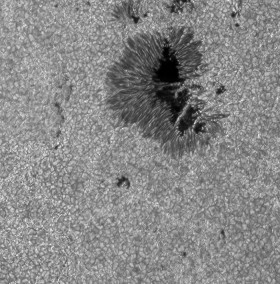|
Press Release 8/2004, August 2nd, 2004
How Strongly Does the Sun Influence the Global Climate?
Studies at the Max Planck Institute for Solar System Research reveal:
solar activity affects the climate but plays only a minor role in the
current global warming.
Since the middle of the last century, the Sun is in a phase of
unusually high activity, as indicated by frequent occurrences of
sunspots, gas eruptions, and radiation storms. Researchers at the Max
Planck Institute for Solar System Research (MPS) in Katlenburg-Lindau
(Germany) and at the University of Oulu (Finland) have come to this
conclusion after they have succeeded in reconstructing the solar
activity based on the sunspot frequency since 850 AD. To this end,
they have combined historical sunspot records with measurements of the
frequency of radioactive isotopes in ice cores from Greenland and the
Antarctic. As the scientists have reported in the renowned scientific
journal, Physical Review Letters, since 1940 the mean sunspot number
is higher than it has ever been in the last thousand years and two and
a half times higher than the long term average. The temporal variation
in the solar activity displays a similarity to that of the mean
temperature of the Earth. These scientific results therefore bring the
influence of the Sun on the terrestrial climate, and in particular its
contribution to the global warming of the 20th century, into the
forefront of current interest. However, researchers at the MPS have
shown that the Sun can be responsible for, at most, only a small part
of the warming over the last 20-30 years. They took the measured and
calculated variations in the solar brightness over the last 150 years
and compared them to the temperature of the Earth. Although the
changes in the two values tend to follow each other for roughly the
first 120 years, the Earth?s temperature has risen dramatically in the
last 30 years while the solar brightness has not appreciably increased
in this time.
Astronomers have regularly observed sunspots since the invention of
the telescope in the early 17th century. These are areas on the
surface of the Sun where energy flow from the interior is reduced due
to the strong magnetic fields that they exhibit. As a result, these
regions cool by about 1500? and thus appear relatively darker than
their surroundings at 5800?. The number of sunspots varies over an
11-year activity period, which in turn is subject to longer term
variations. For example, in the second half of the 17th century, there
were hardly any sunspots at all.
The German-Finnish research team has now applied a new method to
obtain insight into the development of the sunspot number from before
the beginning of direct records. In addition, these experts have
analyzed measured abundances of beryllium-10 in ice cores from
Greenland and the Antarctic. This radioactive isotope is created when
energetic particles in cosmic rays enter the Earth?s atmosphere and
split atomic nuclei of nitrogen and oxygen. Beryllium-10 (half-life
1.6 million years) is a product of this decay process, which is then
washed out of the atmosphere by precipitation and then deposited in
layers in the polar ice fields. Since the cosmic rays are partially
deflected by the solar magnetic field filling interplanetary space,
the production rate of Beryllium-10 in the atmosphere varies with the
strength of this magnetic field, which in turn is associated with the
number of sunspots.

|
Figure 1: Extended group of sunspots visible in the southern
hemisphere of the Sun in September 1998. These sunspots are
fascinating not only due to their large size, but also due to their
detailed structure that reveals a dynamic complexity. The smallest
visible features are about 350 km across, the entire area covers about
200,000 km in the horizontal direction. The sub-pictures in this
mosaic were obtained with the German Vacuum Tower Telescope at the
Observatorio del Teide (Teneriffe).
(Image: Kiepenheuer Institute for Solar Physics, Freiburg im Breisgau)
|
A comparison of the Beryllium-10 data with the historical records of
sunspot numbers reveals a high degree of correlation. Thus it was
possible for the researchers to test and calibrate this new
reconstruction method. The solar research team has managed, for the
first time, to substantiate with consistent physical models every link
in the complex chain, from the isotope abundance in the ice back to
the sunspot number. This includes the creation of Beryllium-10 by
cosmic rays, the modulation of the cosmic rays by the interplanetary
magnetic field, and finally the relationship between the solar
magnetic field and the number of sunspots. In this way it was possible
for the scientists to obtain, for the first time, a reliable,
quantitative determination of the sunspot numbers even for times
before direct measurements were made.
These data show clearly that the Sun is in a state of unusually high
activity, for about the last 60 years. The time interval for which
this statement can be made has been tripled by these new
investigations, for now the reconstructed sunspot numbers extend back
to 850 AD. Another period of enhanced solar activity, but with
substantially fewer sunspots than now, occurred in the Middle Ages
from 1100 to 1250. At that time, a warm period reigned over the Earth,
as the Vikings established flourishing settlements in Greenland.

|
Figure. 2: A large sunspot visible on the Sun in June 2000. The
picture shows a section of the Sun ?s surface 80,000 by 80,000 km
across. Sunspots appear darker than their surroundings because their
strong magnetic fields suppress the energy transported by gas
flows. This picture was taken with the German Vacuum Tower Telescope
at the Observatorio del Teide (Teneriffe).
(Image: Kiepenheuer Institute for Solar Physics, Freiburg im Breisgau)
|
The Sun affects the climate through several physical processes: For
one thing, the total radiation, particularly that in the ultraviolet
range, varies with solar activity. When many sunspots are visible, the
Sun is somewhat brighter than in "quiet" times and radiates
considerably more in the ultraviolet. On the other hand, the cosmic
ray intensity entering the Earth?s atmosphere varies opposite to the
solar activity, since the cosmic ray particles are deflected by the
Sun?s magnetic field to a greater or lesser degree. According to a
much discussed model proposed by Danish researchers, the ions produced
by cosmic rays act as condensation nuclei for larger suspension
particles and thus contribute to cloud formation. With increased solar
activity (and stronger magnetic fields), the cosmic ray intensity
decreases, and with it the amount of cloud coverage, resulting in a
rise of temperatures on the Earth. Conversely, a reduction in solar
activity produces lower temperatures.
Two scientists from the MPI for Solar System Research have calculated
for the last 150 years the Sun?s main parameters affecting climate,
using current measurements and the newest models: the total radiation,
the ultraviolet output, and the Sun?s magnetic field (which modulates
the cosmic ray intensity). They come to the conclusion that the
variations on the Sun run parallel to climate changes for most of that
time, indicating that the Sun has indeed influenced the climate in the
past. Just how large this influence is, is subject to further
investigation. However, it is also clear that since about 1980, while
the total solar radiation, its ultraviolet component, and the cosmic
ray intensity all exhibit the 11-year solar periodicity, there has
otherwise been no significant increase in their values. In contrast,
the Earth has warmed up considerably within this time period. This
means that the Sun is not the cause of the present global warming.
These findings bring the question as to what is the connection between
variations in solar activity and the terrestrial climate into the
focal point of current research. The influence of the Sun on the Earth
is seen increasingly as one cause of the observed global warming since
1900, along with the emission of the greenhouse gas, carbon dioxide,
from the combustion of coal, gas, and oil. "Just how large this role
is, must still be investigated, since, according to our latest
knowledge on the variations of the solar magnetic field, the
significant increase in the Earth?s temperature since 1980 is indeed
to be ascribed to the greenhouse effect caused by carbon dioxide,"
says Prof. Sami K. Solanki, solar physicist and director at the Max
Planck Institute for Solar System Research.
Original work
Natalie A. Krivova, Sami K. Solanki
Solar Variability and Global Warming: A Statistical Comparison Since 1850
Adv. Space Res. 34, 361-364 (2004)
Ilya G. Usoskin, Sami K. Solanki, Manfred Schuessler, Kalevi Mursula,
Katja Alanko
A Millemium Scale Sunspot Reconstruction: Evidence For an Unusually
Active Sun Since the 1940's
Physical Review Letters 91, 211101-1--211101-4 (2003)
Sami K. Solanki, Natalie A. Krivova
Can Solar Variability Explain Global Warming Since 1970?
Journal of Geophysical Research 108 (A5), 1200 (8 Seiten) (2003)
Contact
Prof. Dr. Sami K. Solanki
Max-Planck-Institut for Solar System Research
Tel.: 552 / 325
Fax : 190
 solanki@linmpi.mpg.de
solanki@linmpi.mpg.de
Prof. Dr. Manfred Schüssler
Max-Planck-Institut for Solar System Research
Tel.: 469
Fax : 190
 schuessler@linmpi.mpg.de
schuessler@linmpi.mpg.de
|
